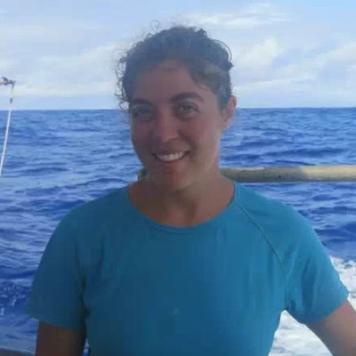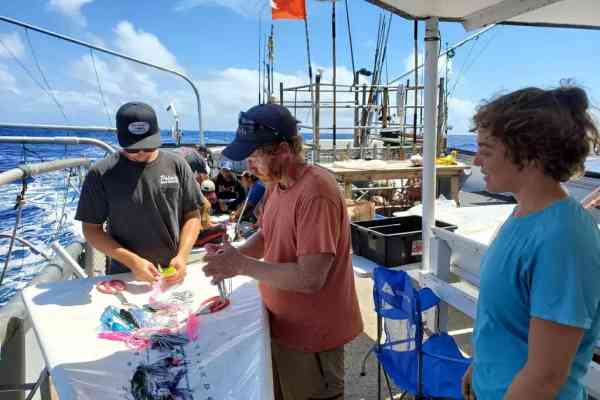Napo'opo'o native, Giulia Anderson, is an SPC fisheries molecular geneticist embarked on the 2021 6-week research expedition to monitor the health of the world’s largest tuna fishery, an activity no other SPC scientist was able to do this year, for the second year in a row, due to the COVID-19 pandemic. This is her onboard diary…
Hello outside world, here is the latest news from the big blue! We crossed the equator on 10 August. This year our entire crew had previously sailed across the equator so the major celebrations of becoming a ‘shellback’ (one who has crossed the equator) did not apply. Still, taggers Chris and Ben took a light-hearted moment to give each other rather creative haircuts!
As we shift into equatorial waters, the patterns of fishing change to accommodate what the fish respond to. Back to the 2:00 a.m. jigging sessions! This is where it is crucial to have plenty of skilled tuna fishermen who know how to use all the different gear we are employing on Gutsy Lady 4 to bring tuna safely onboard in the best condition required for archival tag surgeries. The crew are also getting more enthusiastic about trash-talking with the tagging/science team, which is the most popular past time during the hours of pre-dawn jigging….
A personal highlight of the week was when a jigging session brought up 300 fish (an extremely impressive number), but also put 22 in the biosampling bin, which is a lot of work for the biosampler! So, all four tagging crewmates (after five hours of heavy fishing) took their 40 minute break between buoys, to process the samples like an absolute machine. Now THAT is teamwork at its best!
Captain Tim was extremely proud when he caught a 70 lb. yellowfin on his rod, knocking Jeff off the leader board for the trip…
The fishing is good, winds are almost null and sea conditions are perfect, so what is wrong with this picture? Wait a minute, how far is Honolulu? 1435 nautical miles. Ahhhh! Better not forget we are on a machine that is moving at the pace of a lazy bike… We need about seven days of constant steaming to cover this distance and we need to be back to port on the 23rd. Captain, start to point the bow north!
The sharing of drifting FAD buoy positions continues to benefit the 2021 Pacific tuna tagging cruise in these last days of the cruise. By having access to so many buoys spread across the region, rather than being restricted to our immediate area, we planned accordingly to make an early and gradual turn towards home port. This would allow us to hit highly productivity buoys while also heading in the right direction, rather than staying in equatorial waters until the last minute before making the week-long steam home in a single shot. Much nicer to fish those extra couple days and break up the steaming time.
The final fishing session happened on the 18 August at about 10° N', 166° W, resulting in about 150 more tagged tuna that brought the cruise total to 7866 fish… a central Pacific cruise record broken!
Cleaning and breaking down the fishing gear started straight away. It is fascinating to watch the fishing crew dismantle the more infrastructural additions made to the boat for the tagging cruise (the sprayers and dangler poles and cradles/tables, etc., that take up a big portion of the deck) to prep the boat for a quick return to its normal state as a longliner. Makes one appreciate how much change the boat owners and captains accommodate to make the cruise even possible.
Once the fishing gear is put away, it's a matter of itemising, cleaning and packing everything for the next cruise. In some cases, like this, it’s pretty easy because we used up plenty of gear this year and there aren't nearly as many jigs, dangler lures or biosampling bags as when we started. In other cases, it can be a bit of a headache playing Tetris to fit all the gear into storage boxes.
We are now punching our way up-current and up-swell, which has made for some slightly rocky days onboard. We all got a bit spoiled in the equatorial calm and are re-remembering to keep round and top-heavy objects (glasses of juice, water bottles, fruit, etc.) properly contained or else they go flying. And likewise, how to walk like a true seaman – in a non-linear route, bumping into clearly stationary objects, in a way one would be suspect of intoxication if conducted anywhere except at sea. The former leads to frustrating clean ups. The latter is mostly just funny to watch.
Only a few more days left and we'll be in port. Final distance covered will be roughly 5400 nautical miles….
What a voyage!

